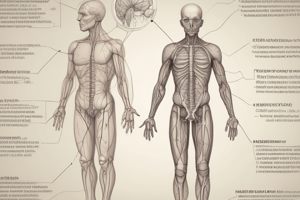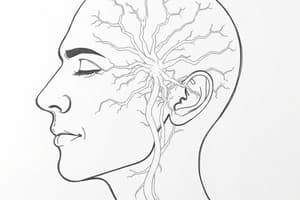Podcast
Questions and Answers
Which of the following conditions is not classified under metabolic causes of peripheral neuropathies?
Which of the following conditions is not classified under metabolic causes of peripheral neuropathies?
- Diabetes mellitus
- Renal failure
- Porphyria
- Guillain-Barré syndrome (correct)
What are common sensory manifestations of peripheral neuropathies?
What are common sensory manifestations of peripheral neuropathies?
- Blurred vision
- Muscular weakness
- Difficulty in breathing
- Numbness (correct)
Which of the following is NOT a vitamin deficiency associated with peripheral neuropathies?
Which of the following is NOT a vitamin deficiency associated with peripheral neuropathies?
- Vitamin B1
- Vitamin E
- Vitamin B12
- Vitamin C (correct)
What is a characteristic microscopic finding in Chronic Inflammatory Demyelinating Polyneuropathy?
What is a characteristic microscopic finding in Chronic Inflammatory Demyelinating Polyneuropathy?
Among the following, which condition is classified as a hereditary neuropathy?
Among the following, which condition is classified as a hereditary neuropathy?
Which chromosome is primarily affected in Charcot-Marie-Tooth disease?
Which chromosome is primarily affected in Charcot-Marie-Tooth disease?
What is the inheritance pattern of Refsum's disease?
What is the inheritance pattern of Refsum's disease?
What is a potential autonomic manifestation of peripheral neuropathy?
What is a potential autonomic manifestation of peripheral neuropathy?
Which toxic substance is incorrectly associated with causing peripheral neuropathies?
Which toxic substance is incorrectly associated with causing peripheral neuropathies?
Which of the following symptoms is NOT associated with Refsum's disease?
Which of the following symptoms is NOT associated with Refsum's disease?
What type of neuropathy is commonly associated with multiple myeloma?
What type of neuropathy is commonly associated with multiple myeloma?
Which of the following is a recognized complication of diabetic neuropathy?
Which of the following is a recognized complication of diabetic neuropathy?
Which type of neuropathy is characterized by muscular atrophy and paralysis?
Which type of neuropathy is characterized by muscular atrophy and paralysis?
What type of injury most commonly leads to compression neuropathy in the median nerve?
What type of injury most commonly leads to compression neuropathy in the median nerve?
What is the role of heavy metals in peripheral neuropathies?
What is the role of heavy metals in peripheral neuropathies?
Déjérine-Sottas disease primarily affects which population?
Déjérine-Sottas disease primarily affects which population?
What type of trauma can lead to peripheral neuropathies?
What type of trauma can lead to peripheral neuropathies?
What is a key histological feature of Charcot-Marie-Tooth disease?
What is a key histological feature of Charcot-Marie-Tooth disease?
During which stage does the weakness and atrophy of calf muscles typically begin in Charcot-Marie-Tooth disease?
During which stage does the weakness and atrophy of calf muscles typically begin in Charcot-Marie-Tooth disease?
What causes traumatic neuropathies?
What causes traumatic neuropathies?
Which type of diabetic neuropathy specifically affects the pelvic area and can lead to weakness in the legs?
Which type of diabetic neuropathy specifically affects the pelvic area and can lead to weakness in the legs?
What is the primary pathological mechanism leading to diabetic neuropathy?
What is the primary pathological mechanism leading to diabetic neuropathy?
In Guillain-Barré syndrome, which test result is typically observed?
In Guillain-Barré syndrome, which test result is typically observed?
What symptom is most associated with autonomic neuropathy in diabetic patients?
What symptom is most associated with autonomic neuropathy in diabetic patients?
What is a common trigger for Guillain-Barré syndrome?
What is a common trigger for Guillain-Barré syndrome?
Which of the following is not a clinical feature of diabetic neuropathy?
Which of the following is not a clinical feature of diabetic neuropathy?
What is the effect of increased levels of sorbitol in diabetic neuropathy?
What is the effect of increased levels of sorbitol in diabetic neuropathy?
What is a characteristic microscopic finding in Guillain-Barré syndrome?
What is a characteristic microscopic finding in Guillain-Barré syndrome?
Which statement about diabetic neuropathy is accurate?
Which statement about diabetic neuropathy is accurate?
Which condition is characterized by life-threatening ascending paralysis?
Which condition is characterized by life-threatening ascending paralysis?
Flashcards
What are peripheral neuropathies?
What are peripheral neuropathies?
A group of disorders affecting the peripheral nerves, disrupting the normal conduction of signals.
What are some metabolic causes of peripheral neuropathies?
What are some metabolic causes of peripheral neuropathies?
Diabetes, kidney failure, liver disease, and porphyria are examples of metabolic conditions that can damage peripheral nerves.
What are some autoimmune causes of peripheral neuropathies?
What are some autoimmune causes of peripheral neuropathies?
Guillain-Barré syndrome, lupus, rheumatoid arthritis, and chronic inflammatory demyelinating neuropathy are autoimmune diseases that can cause damage to peripheral nerves.
What are some infectious causes of peripheral neuropathies?
What are some infectious causes of peripheral neuropathies?
Signup and view all the flashcards
What are some toxic causes of peripheral neuropathies?
What are some toxic causes of peripheral neuropathies?
Signup and view all the flashcards
What are some hereditary causes of peripheral neuropathies?
What are some hereditary causes of peripheral neuropathies?
Signup and view all the flashcards
What are some vitamin deficiencies that can cause peripheral neuropathies?
What are some vitamin deficiencies that can cause peripheral neuropathies?
Signup and view all the flashcards
What are some traumatic causes of peripheral neuropathies?
What are some traumatic causes of peripheral neuropathies?
Signup and view all the flashcards
What are some other causes of peripheral neuropathies?
What are some other causes of peripheral neuropathies?
Signup and view all the flashcards
How do peripheral neuropathies present clinically?
How do peripheral neuropathies present clinically?
Signup and view all the flashcards
What is Peripheral Neuropathy?
What is Peripheral Neuropathy?
Signup and view all the flashcards
What is Proximal Neuropathy?
What is Proximal Neuropathy?
Signup and view all the flashcards
What is Autonomic Neuropathy?
What is Autonomic Neuropathy?
Signup and view all the flashcards
What is Focal Neuropathy?
What is Focal Neuropathy?
Signup and view all the flashcards
What is Micro-vascular injury?
What is Micro-vascular injury?
Signup and view all the flashcards
How do glycosylated proteins affect nerve conduction?
How do glycosylated proteins affect nerve conduction?
Signup and view all the flashcards
How does protein kinase C affect nerve conduction?
How does protein kinase C affect nerve conduction?
Signup and view all the flashcards
How does sorbitol affect diabetic neuropathy?
How does sorbitol affect diabetic neuropathy?
Signup and view all the flashcards
What is the cause of Guillain-Barré Syndrome?
What is the cause of Guillain-Barré Syndrome?
Signup and view all the flashcards
What are the main characteristics of Guillain-Barré Syndrome?
What are the main characteristics of Guillain-Barré Syndrome?
Signup and view all the flashcards
Chronic Inflammatory Demyelinating Polyneuropathy (CIDP)
Chronic Inflammatory Demyelinating Polyneuropathy (CIDP)
Signup and view all the flashcards
Charcot-Marie-Tooth Disease
Charcot-Marie-Tooth Disease
Signup and view all the flashcards
Refsum's Disease
Refsum's Disease
Signup and view all the flashcards
Déjérine-Sottas Disease
Déjérine-Sottas Disease
Signup and view all the flashcards
Neuropathies Associated with Malignancy
Neuropathies Associated with Malignancy
Signup and view all the flashcards
Traumatic Neuropathies
Traumatic Neuropathies
Signup and view all the flashcards
Carpal Tunnel Syndrome
Carpal Tunnel Syndrome
Signup and view all the flashcards
Remyelination
Remyelination
Signup and view all the flashcards
Demyelination
Demyelination
Signup and view all the flashcards
"Onion Bulb" Appearance
"Onion Bulb" Appearance
Signup and view all the flashcards
Study Notes
Peripheral Neuropathies
- Peripheral neuropathies (PN) are a group of disorders that disrupt normal impulse conduction in peripheral nerves.
Causes of Peripheral Neuropathies
- Metabolic: Diabetes mellitus (common), renal failure, liver failure, porphyria.
- Autoimmune diseases: Guillain-Barré syndrome, systemic lupus erythematosus (SLE), rheumatoid arthritis, chronic inflammatory demyelinating neuropathy.
- Infections: Leprosy, diphtheria, varicella zoster, Epstein Barr virus (EBV), HIV.
- Toxic: Heavy metals (arsenic, lead, mercury), drugs (metronidazole, phenytoin, vincristine), organic solvents (toluene, N-hexane).
- Hereditary: Charcot-Marie-Tooth disease, Refsum's disease, Déjérine-Sottas disease, hereditary sensory neuropathy.
- Vitamin deficiencies: Vitamin B1, B3, B6, B12, E.
- Trauma to the nerve: Compression by a tumor, cutting in accidents, electric discharge.
- Others: Infiltration of the nerve by a malignant tumor, exposure to radiation, amyloid deposition in the nerve.
Clinical Features of Peripheral Neuropathies
- Combination of sensory, motor, and occasionally autonomic manifestations.
Sensory Manifestations
- Pain
- Burning
- Tingling
- Numbness
Motor Manifestations
- Muscular weakness
- Muscular twitches
- Muscular atrophy
- Paralysis
- Difficulty in breathing or swallowing
Autonomic Manifestations
- Blurred vision
- Decrease sweat
- Dizziness
- Nausea and vomiting
- Diarrhea or constipation
- Urinary incontinence
Diabetic Neuropathy
- Common complication of diabetes, causing significant morbidity and mortality worldwide.
- Significant risk for amputation.
- Four types:
- Peripheral neuropathy: Damages peripheral nerves, affecting feet and legs, causing pain, burning, tingling, or numbness.
- Proximal neuropathy: Affects nerves in the thighs, hips, and buttocks, causing pain and weakness in the legs.
- Autonomic neuropathy: Affects nerves controlling bodily functions (e.g., GIT, urinary, genital, and vascular systems), causing nausea, vomiting, diarrhea, constipation, dizziness, fainting, and sexual dysfunction.
- Focal neuropathy: Affects a specific nerve or area, causing eye pain, chest pain, Bell's palsy, etc.
Pathogenesis of Diabetic Neuropathy
- Microvascular injury: Damage to small blood vessels supplying nerves, leading to neural ischemia.
- Increased levels of glycosylated proteins in nerve tissue, reducing conduction.
- Increased levels of protein kinase C, decreasing nerve conduction.
- Increased sorbitol levels in the sorbitol/reductase pathway, leading to microangiopathy.
Guillain-Barré Syndrome (GBS)
- Definition: Acute inflammatory demyelinating disease, an immune-mediated disorder, often following a viral infection (e.g., Cytomegalovirus, Epstein-Barr virus) or Campylobacter jejuni.
- Target: Gangliosides in nerves, attacked by antibodies.
- Clinical features: A life-threatening ascending paralysis beginning in the hands and feet, progressing to proximal muscles, and often affecting respiratory muscles, causing respiratory failure.
- Symptoms: Asymmetrical weakness of lower limbs, progressing to the upper limbs and the trunk, slowed nerve conduction velocity, elevated CSF protein, and no inflammatory cells.
- Microscopic: Segmental demyelination of the nerve, chronic inflammatory cell infiltration in the nerve (microscopic details shown in images).
Chronic Inflammatory Demyelinating Polyneuropathy (CIDP)
- Similar to GBS, but with a sub-acute or chronic course with relapses and remissions.
- Microscopic: Shows recurrent demyelination and remyelination - the "onion bulb" appearance.
Charcot-Marie-Tooth Disease
- Most common hereditary form of PN.
- Autosomal dominant disease.
- Defects primarily on chromosome 17 but less frequently on chromosome 1, affecting the myelin sheath.
- Occurs in young adults.
- Weakness and atrophy of calf muscles.
- Microscopic: Segmental demyelination and "onion bulb" appearance.
Refsum's Disease
- Autosomal recessive.
- Faulty accumulation of phytanic acid results in myelin sheath malformation in the nerves.
- Blood levels of phytanic acid are increased in patients (10-50 mg/dL, versus normal <0.2 mg/dL).
- Accounts for 5-30% of serum lipids in patients.
- Symptoms typically develop slowly and insidiously from childhood to adulthood and include peripheral polyneuropathy, cerebellar ataxia, and scaly skin.
Déjérine-Sottas Disease
- Autosomal dominant, mostly defects on chromosomes 17 and 1.
- Occurs in infants, often with progressive upper and lower extremity weakness, and muscle atrophy.
- Severe segmental demyelination with prominent "onion bulbs"
Neuropathies Associated with Malignancy
- Causes: Infiltration or compression by a tumor, circulation of anti-neuronal proteins (e.g., in some lung cancers), deposition of amyloid in nerves (e.g., in multiple myeloma).
Traumatic Neuropathies
- Causes: Lacerations and fractures.
- Traumatic neuromas: Painful nodules of tangled axons and connective tissue after nerve injury; examples of compression related conditions like carpal tunnel syndrome.
- Compression neuropathy: Commonly occurs in the median nerve, such as carpal tunnel syndrome.
Carpal Tunnel Syndrome
- Due to compression of the median nerve at the wrist joint.
- Most cases are idiopathic.
- Possible causes include: bone fractures, dislocation of carpal bones, hematoma, inflammatory reaction.
- Clinical manifestations: Pain, numbness, burning or tingling in the thumb, index, and middle fingers. In chronic cases, atrophy of the thenar muscles.
Studying That Suits You
Use AI to generate personalized quizzes and flashcards to suit your learning preferences.




